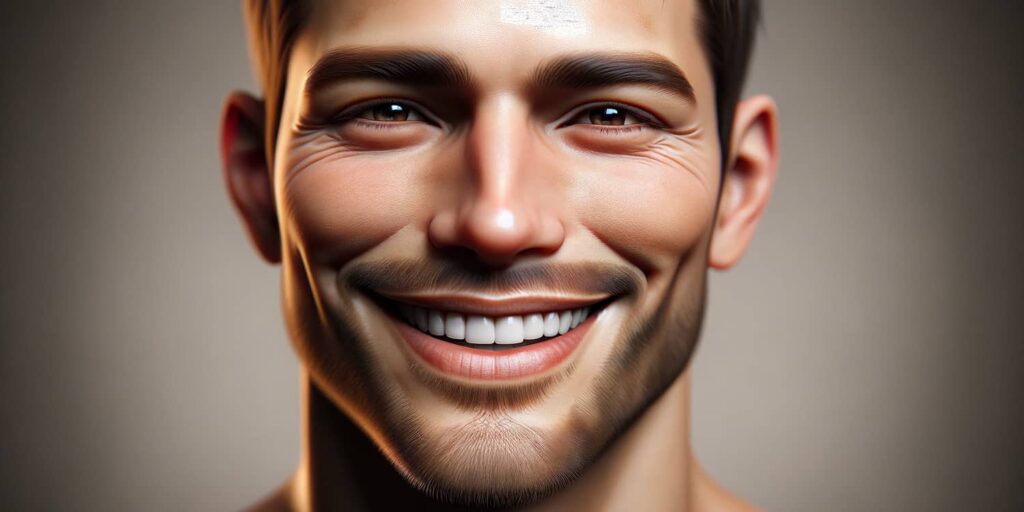New research demonstrates that women’s preferences for certain male facial features are influenced by the perceived emotions on those faces. The findings, published in Evolutionary Human Sciences, indicate that masculine faces are perceived as more attractive when they display a happy expression, suggesting that positive emotions can offset the negative perceptions linked to masculine facial features.
Previous research has identified three key factors that influence facial attractiveness: symmetry, averageness, and sexually dimorphic features (traits that differ between the sexes). Interestingly, sexually dimorphic features, particularly in men, have been a subject of debate. Some theories, like the immunocompetence hypothesis, suggest that masculine traits in men, such as a strong jawline, signal a robust immune system, making them more attractive to women. However, this theory has been contested, with other studies finding feminine male faces more appealing to women.
This inconsistency led researchers to delve deeper, considering other factors like cultural and environmental influences, perceptions of dominance, and associations with traits like fidelity. Another intriguing angle explored the idea that emotional expressions might play a role in this complex dynamic, potentially influencing the attractiveness of masculine traits.
“The frequently conflicting findings surrounding facial attractiveness and sexual dimorphism have meant that our understanding has remained elusive. This study acknowledges this perplexity and puts forth a novel alternative explanation for why women may not exhibit expected attraction to facial masculinity, as posited by the immunocompetence hypothesis,” explained lead author Mariana Carrito, a postdoctoral researcher at Centre for Psychology at University of Porto and manager of the Porto Sexlab.
To investigate the relationship between masculine facial features, emotional expressions, and perceived attractiveness, Carrito and her colleagues conducted a series of three experiments.
Experiment 1 was designed to explore how sexually dimorphic differences in face morphology influence the perception of emotions in neutral faces. The study involved 75 participants, including 36 men and 39 women. The stimuli consisted of 24 composite faces, which were manipulated using Psychomorph software to create feminized and masculinized versions. The experiment ensured that only one version of each individual face was presented to the participants.
Participants were asked to evaluate these neutral faces in terms of perceived facial expression (anger or happiness). They used a 100-point visual analogue scale ranging from “Not angry” to “Angry” or “Not happy” to “Happy”. Faces were presented in blocks, with the order of presentation randomized.
The results revealed that masculinized faces, regardless of being male or female, were associated with increased anger evaluations compared to their feminized counterparts. Similarly, masculinized male faces were associated with lower happiness evaluations compared to feminized male faces. In summary, male faces were generally perceived as angrier, and female faces as happier, with masculinization enhancing the perception of anger and feminization enhancing the perception of happiness.
Experiment 2 sought to understand whether facial expressions influence the perception of masculinity, particularly in male faces. The study involved 35 heterosexual Caucasian women with normal or corrected vision, aged between 18 and 35 years.
The stimuli were 90 photographed faces from the Karolinska Directed Emotional Faces, depicting three different emotions (angry, neutral, and happy) each. These faces were manipulated to create three levels of masculinization. Participants rated how masculine each male face appeared on a visual scale from 0 (extremely feminine) to 100 (extremely masculine).
Experiment 2 found a significant effect of emotional expression on perceived masculinity. Angry faces were rated as more masculine compared to happy and neutral faces. This result suggests a perceptual connection between anger and masculinity in facial expressions.
Experiment 3 aimed to explore female preferences for masculinity in faces with varying emotional expressions. The sample comprised 84 heterosexual Caucasian women aged 18-34, with six participants later excluded due to rapid, seemingly random responses.
Using 30 male faces from the Karolinska Directed Emotional Faces, the researchers created a continuum of 11 images for each face, ranging from -50% to +50% masculinisation. Participants manipulated these images to achieve what they perceived as the most attractive appearance.
Participants showed a general preference for femininity across all emotional expressions but to varying degrees. The preference for femininity was significantly lower in happy male faces compared to neutral or angry faces. This suggests that happy expressions can mitigate the negative connotations associated with masculinity, influencing women’s preferences in male faces.
“Results show that women prefer decreased feminization (or an increased masculinization) in happy male faces,” Carrito told PsyPost. “Such findings, may offer valuable insights into the intricate psychology of attraction. Women might feel more attracted to masculinity in men when they are smiling, possibly because the expression of happiness mitigates the negative associations linked with masculinity, such as perceived hostility.”
But the study, like all research, includes some caveats. The study’s sample was predominantly Caucasian and heterosexual, which may limit the generalizability of the results to other ethnicities and sexual orientations. Cultural differences in perceptions of masculinity and emotional expression could lead to different preferences in facial features, suggesting a need for more diverse participant samples in future studies. Additionally, the study primarily used digital manipulations of facial features to assess preferences, which may not entirely capture the natural variability and subtlety found in real human faces.
Nevertheless, the findings highlight the importance of considering more than just static facial features in attractiveness research, as the dynamic aspect of facial expressions plays a crucial role.
“To our knowledge, this study is the first to explore the relationship between the preferences of women for the sexually dimorphic shape of male faces and the perception of emotional expressions,” the researchers concluded. “Based on the three experiments, we conclude that emotional expression does impact women’s preferences for male masculinity. The extent of the interaction between expression and masculinity is unknown, but differences in mouth curvature and hence apparent resting expression may contribute to the divergence in the results of studies on attraction to masculinity.”
The study, “When he smiles: Attractiveness preferences for male faces expressing emotions“, was authored by Mariana L. Carrito, Francisca Bismarck, Pedro Bem-Haja, David I. Perrett, and Isabel M. Santos.

